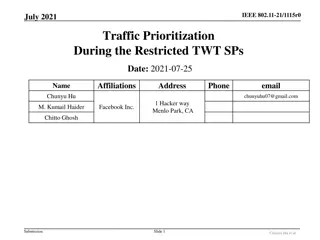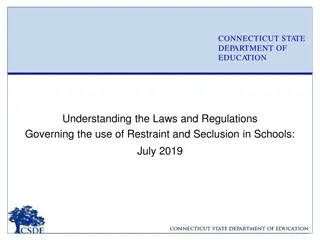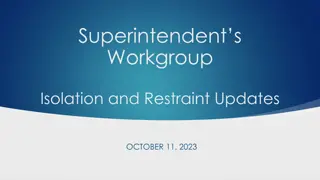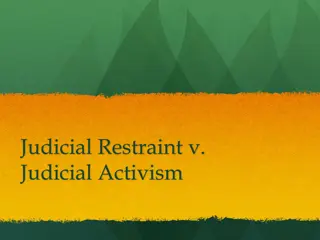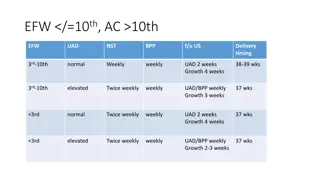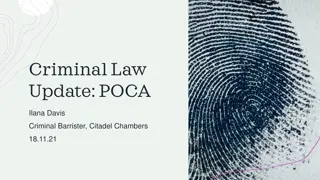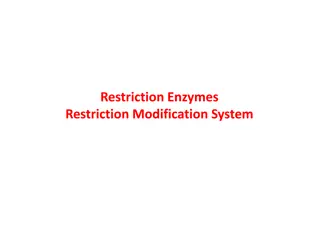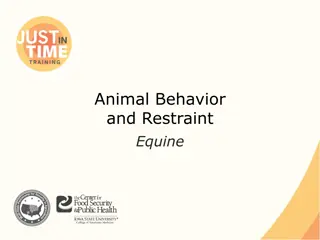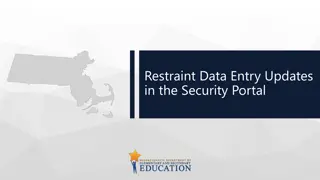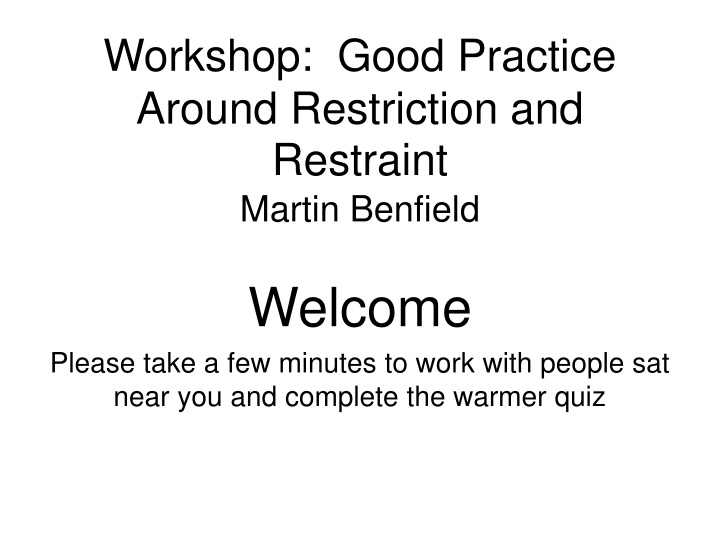
Good Practice Around Restriction and Restraint Workshop Insights
Explore key insights from a workshop on good practice around restriction and restraint, including revisiting definitions, exploring components of restraint, and discussing when restraint is permissible under the Mental Capacity Act. Learn from real-life examples and considerations for decision-making and recording practices.
Download Presentation

Please find below an Image/Link to download the presentation.
The content on the website is provided AS IS for your information and personal use only. It may not be sold, licensed, or shared on other websites without obtaining consent from the author. If you encounter any issues during the download, it is possible that the publisher has removed the file from their server.
You are allowed to download the files provided on this website for personal or commercial use, subject to the condition that they are used lawfully. All files are the property of their respective owners.
The content on the website is provided AS IS for your information and personal use only. It may not be sold, licensed, or shared on other websites without obtaining consent from the author.
E N D
Presentation Transcript
Workshop: Good Practice Around Restriction and Restraint Martin Benfield Welcome Please take a few minutes to work with people sat near you and complete the warmer quiz
Objectives: - Revisit the MCA definition of restraint; - Explore what constitutes restraint; - Clarify when restraint falls within the provisions of the Mental Capacity Act and when it would not; - Consider key components of good practice for decision making and recording;
Cornwall Inquiry (2006) Our investigation found that Institutional abuse was widespread, preventing people from exercising their rights to independence, choice and inclusion. One person spent 16 hours a day tied to their bed or wheelchair, for what staff believed was for their own protection.
Re M (October 2013) 32 restricted and impoverished quality of life in the home no fault of the home itself .. most ways not a suitable place for her .. what the home does offer is the best available quality of care for her diabetes management, but at what cost? . Almost complete certainty of physical safety at the cost of the happiness of M .
When is restraint permitted (1) In some circumstances restraint is the right thing to do, and not to do so on these occasions could be considered neglect. Restraint can be used: if the person consents to it, perhaps because it makes them feel safer if it is part of a care plan agreed by all
When is restraint permitted (2) if the person lacks the capacity to consent, but is acting in a way that may cause harm to themselves or others. In this case, The Mental Capacity Act 2005 helps us to understand that restraint can be used if it is believed to be in the individual s best interests, but it must be the least restrictive option and used for the minimum amount of time . (Scie 2009)
Duty of Care and Liability Duty of care + Breach of duty + Causation = Liability (personal or vicarious?) Reasonable steps to avoid acts or omissions which could reasonably foresee would lead to harm. Regard to Codes of Practice and cogent reasons if departing from codes (Munjaz) Bolam in Bolitho: Reasonable percentage body of opinion with logical basis.
MCA definition of Restraint: Restraint is defined as the use or threat of force where P resists OR any restriction of P's liberty of movement, whether or not P resists {Section 6(4) MCA} Restraint is only permitted if the person using it: - Believes that it is necessary to prevent harm to P; {Section 6(2) MCA} and - The restraint is a proportionate response to the likelihood and seriousness of harm {Section 6(3) MCA}
What might constitute restraint? . restraint conjures up a picture of residents being tied in chairs or held down with force. These are examples of physical restraint, but also use of medication, a confusing layout, key pad systems or reminders to stay sitting down. Actions that restrain a resident may even be unintentional (SCIE Website 2009, accessed June 2019):
Case Law: Medication as Restriction G, E and F v Local Authority (2010) Haloperidol was one of the restrictions leading to conclusion of a deprivation of liberty. BB v AM (2010) Anti-psychotic medication listed as one of the restrictions leading to a deprivation of liberty. Surrey CC v P & Q (2011) Lord justice Wilson, Court of Appeal, referring to the use of Respiridone for anxiety
MHA Code Of Practice 3.6... some instances, competing human rights will need to be considered. Such decisions and the reasons for them should be clearly documented. Decisions restricting a person s rights... justifiable as necessary and proportionate.
SCIE Guidance Understand what restraint is Using the physical environment to promote a sense of wellbeing can help avoid some of the situations that result in the use of restraint. staff need opportunities to develop their skills and knowledge, and to share learning about how to respond to the challenges they face.
SCIE Guidance Using a five-step framework will help with making informed decisions in situations where the use of restraint is being considered. The five steps are: observe, do some detective work, consider the options, implement the plan, monitor and review the plan. (Scie, ibid)
Recording Restraint Reasonable belief P lacks capacity; Describe circumstances; one off or recurrent restraint? Necessity and proportionality to likelihood and severity of harm; Risk assessment Less restrictive option; Evidence of best interests process talking about restraint Review and plans to reduce need for future restraint consideration of plans to enhance wellbeing and support positive risk taking where indicated Any other thoughts?
Talk about restraint The use of restraint is a topic that people can be reluctant to discuss, but talking about it can be useful in many ways: to help staff, residents and relatives understand policy on the use of restraint, and the legal position outlined in the Mental Capacity Act 2005 to explore different views about what might constitute restraint to consider alternative solutions and work out what might be right for an individual. (scie 2009)






